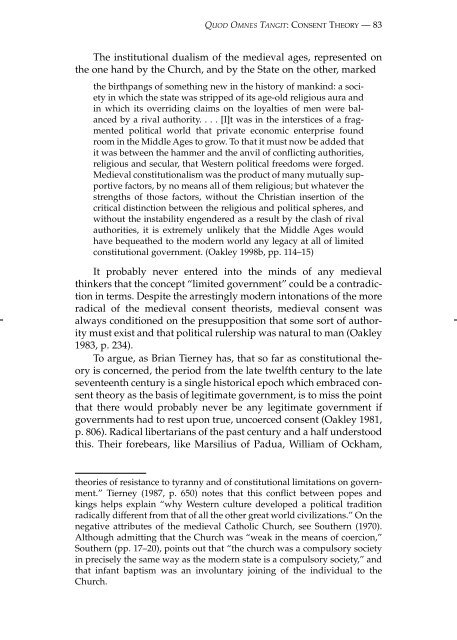Quod Omnes Tangit
Quod Omnes Tangit
Quod Omnes Tangit
Create successful ePaper yourself
Turn your PDF publications into a flip-book with our unique Google optimized e-Paper software.
QUOD OMNES TANGIT: CONSENT THEORY — 83<br />
The institutional dualism of the medieval ages, represented on<br />
the one hand by the Church, and by the State on the other, marked<br />
the birthpangs of something new in the history of mankind: a society<br />
in which the state was stripped of its age-old religious aura and<br />
in which its overriding claims on the loyalties of men were balanced<br />
by a rival authority. . . . [I]t was in the interstices of a fragmented<br />
political world that private economic enterprise found<br />
room in the Middle Ages to grow. To that it must now be added that<br />
it was between the hammer and the anvil of conflicting authorities,<br />
religious and secular, that Western political freedoms were forged.<br />
Medieval constitutionalism was the product of many mutually supportive<br />
factors, by no means all of them religious; but whatever the<br />
strengths of those factors, without the Christian insertion of the<br />
critical distinction between the religious and political spheres, and<br />
without the instability engendered as a result by the clash of rival<br />
authorities, it is extremely unlikely that the Middle Ages would<br />
have bequeathed to the modern world any legacy at all of limited<br />
constitutional government. (Oakley 1998b, pp. 114–15)<br />
It probably never entered into the minds of any medieval<br />
thinkers that the concept “limited government” could be a contradiction<br />
in terms. Despite the arrestingly modern intonations of the more<br />
radical of the medieval consent theorists, medieval consent was<br />
always conditioned on the presupposition that some sort of authority<br />
must exist and that political rulership was natural to man (Oakley<br />
1983, p. 234).<br />
To argue, as Brian Tierney has, that so far as constitutional theory<br />
is concerned, the period from the late twelfth century to the late<br />
seventeenth century is a single historical epoch which embraced consent<br />
theory as the basis of legitimate government, is to miss the point<br />
that there would probably never be any legitimate government if<br />
governments had to rest upon true, uncoerced consent (Oakley 1981,<br />
p. 806). Radical libertarians of the past century and a half understood<br />
this. Their forebears, like Marsilius of Padua, William of Ockham,<br />
theories of resistance to tyranny and of constitutional limitations on government.”<br />
Tierney (1987, p. 650) notes that this conflict between popes and<br />
kings helps explain “why Western culture developed a political tradition<br />
radically different from that of all the other great world civilizations.” On the<br />
negative attributes of the medieval Catholic Church, see Southern (1970).<br />
Although admitting that the Church was “weak in the means of coercion,”<br />
Southern (pp. 17–20), points out that “the church was a compulsory society<br />
in precisely the same way as the modern state is a compulsory society,” and<br />
that infant baptism was an involuntary joining of the individual to the<br />
Church.
















